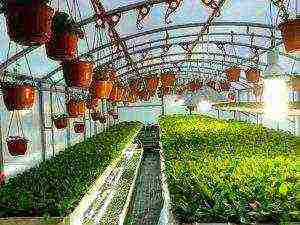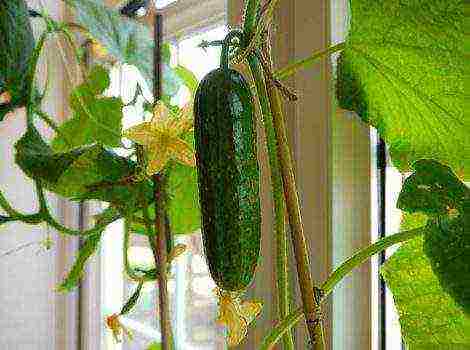It was in the middle of summer. After walking through the forest, we sat down to rest, and suddenly two bear cubs rolled out into the clearing to our fire. Out of surprise, the bears got up on their hind legs and, sniffing, studied us for half a minute. We were scared: according to all laws, a bear is about to appear on the stage. But a man came out of the forest with a stick, and the situation immediately changed. - What are you like a mother to them? - More precisely, the guardian ... So I began my story in 1975 about the meeting with Valentin Sergeevich Pazhetnov, who began an interesting work on the study of bears. Much and little was known about bears - all from short encounters in nature. What could these meetings give? The bear appeared and immediately disappeared into the thicket. How does he live in nature, according to what laws does he develop, how does he interact with the world of animals and people around him? There were many questions, and the answers were sketchy. It would be like walking next to a bear, as, for example, the Englishwoman Jane Goodall walked next to chimpanzees, having infiltrated their group in the rainforest. Alas, this cannot work with adult bears. And with the kids? The idea turned out to be quite feasible. Two teddy bears taken from a den, having “captured” (a special phenomenon in the animal world) a person as their mother, began to follow him everywhere. The man, trying to save the cubs from danger, lived with the maturing animals for two years. This life gave extremely important observations. It was clear what and how the cubs eat, how they relate to each other, how they react to everything they meet, what they are afraid of, at what age they begin to swim, climb trees, how they learn to eat oats, dig up anthills, and so on. The zoologist realized that the experiment was a success, when in late autumn his animals, having built a den, lay down in it. “Waking up in April and seeing me, the cubs first climbed a tree with fright, but I threw a sweatshirt near a pine tree, and the cubs, immediately smelling a familiar smell, ran up to fraternize. And we spent one more summer together. " Living in the wild alongside maturing animals has provided the zoologist with unique and important knowledge. And Pazhetnov had a dream - to return the pupils to nature. However, as it later became clear, the rules of relationship with a person were violated. Until the desired finish, the animals happened to take food from their hands and, being free, began to look for meetings with people, for example, with mushroom pickers, in order to rummage in their baskets. No matter how hard it was, one bear had to be sent to the zoo, the other, wilder one, who had lifted a cow in the village, had to be shot. I then wrote: "It is difficult, almost impossible, to return a beast that has learned the closeness of people and ceased to be afraid of them." And I was wrong. Continuing to work with bears, Pazhetnov took into account the mistakes of the first experiment and began to raise the cubs that fell into his hands, taking into account the accumulated knowledge. And the bears turned out to be able to live, gaining freedom! It was a sensation. The name of Pazhetnov became immediately known in the scientific world. I have always admired my friend - calm, thorough, hardworking, knowledgeable, in this life he is good at doing everything, no matter what he undertakes. He is a blacksmith, a carpenter, a welder, a driver, a tractor driver, a heating engineer, a veterinarian, a hunter-fisherman, who has been hunting for furs in the Yenisei taiga for three years. Hunting passion brought people closer to nature. Having already two children, Valentin entered the Fur and Fur Institute, successfully graduated from it and came to work in the Central Forest Reserve. It was around this time that we got to know each other well, and for twenty-five years now I have been following my friend's life. A good family man - a wife, two children, five grandchildren, Valentin Sergeevich admits that half of all the worries associated with the cubs are shared with him by the "golden Svetlana Ivanovna."And the son in this family is also a zoologist, and the daughter is a biologist. In the Pazhetnovs' house you always feel the atmosphere of friendship, hard work and common interests. But the head of everything, of course, is dad. Over the years of studying bears, he wrote a serious book about them and became a candidate of sciences. "For everyone" he wrote another interesting book "My friends bears", translated from Russian in France, Bulgaria, Czech Republic. Later, the work that summarized the experience of returning the cubs to nature made him a Doctor of Biological Sciences and almost the main "bugbear" in the world - he participates in numerous conferences, visited many countries, people come to him in the Tver forests for experience. The unique work of Pazhetnov was taken under his patronage (financing, equipment supply) by the International Fund for the Protection of Animals. Now Valentin Sergeevich is in charge of the biological station in the far bearish corner of the Tver forests. This is a picturesque place where a village once stood, and now, on the hills and under them, there are dwelling houses of employees (half of which are the Pazhetnov family) and specific buildings - shelters for bear cubs. They get here still tiny - with a mitten, when the mother in the den is killed by hunters. Before, cubs always died. And if someone was tempted to raise a teddy bear, then he did not know what to do with him later - "up to a year it is a teddy bear, and later a beast, jokes with which are bad." Valentin Sergeevich announced in the newspapers that he was taking the cubs to raise. And they are brought here every winter. It takes a long time to talk about all the intricacies of the upbringing methodology. And shortly so. First, the cubs are raised like babies - heat, milk, eggs, semolina, cottage cheese. At the same time, they do this so that the animals do not feel the presence of a person and do not associate his appearance with the food they receive. Bear cubs grow on good nutrition quickly and get on their feet sooner than in nature. They begin to let them out of the "nursery" into the forest, continuing to supply them with food, but as if they themselves had found it. Then, at a strictly defined age, the food is reduced, prompting the cubs to turn to pasture. Bears in search of food and out of curiosity wander over a relatively large territory - four to five kilometers in any direction. They can see on the road a motorcyclist, a grazing cow, an elk, a fox, a badger, and determine their attitude towards them. By the end of July, the cubs are ready for independent life, and they are released in the places where they were born, or where they want to refresh the blood of dying bear populations. Six years ago, Valentin Sergeevich invited me to watch the issue in the Bryansk Forest Reserve ... They got accustomed! Later, there were more issues in the same places. In total, fourteen cubs were moved to the forests near Bryansk. Raising animals is a painstaking and responsible business. “It's easier to take care of a baby,” says Svetlana Ivanovna, who has a lot of almost maternal concerns. "You get attached to them like to children." And what about the surrounding population? Well, first of all, there is not enough of it here. The three nearest villages have a small number of inhabitants. Encounters with cubs are rare and not dangerous. And let us note another talent of Valentin Sergeevich Pazhetnov - his ability to create an atmosphere of goodwill around an important cause. When this time we were driving from the railway to the biological station, an old woman was standing by the highway with a pot of milk. "Sergeich, take a present." This picture is common. Valentin Sergeevich is not only an indisputable authority here, but also a respected person by everyone (everyone!). Not without reason. He himself is ready here to provide everyone and everyone with everyday help, which is especially appreciated today: he will take someone to the hospital, to the station, the old woman will plow a vegetable garden on a tractor, buy medicine, treat the cattle, will certainly attend a wedding, a funeral. This is well known to everyone, and therefore not a single person with a gun will appear on the land of the biological station. Recently, a local lake was assigned to the Pazhetnov farm as a biological resource.What did Valentin Sergeevich do in the first place? He gathered the men and said: “You live here - use the lake as owners, catch as much as you can eat. But let's take care of the lake together. A poacher has appeared, especially with an electric fishing rod - knit and let me know. " Everyone liked it. Not long ago, they nailed a greedy, indiscriminate hunter. Shouts: "I am a policeman!" "We wanted to squeeze you!" Pazhetnov made sure that the policeman was fired from his job, and the chief of the police, who tried to shield him, received a penalty. There is one more side of Valentin Sergeevich's activity. He is a well-known man on the Tver land, his business arouses curiosity in everyone - they go to the biological station. How to be? The presence of people here is undesirable and intolerable. It was decided to create a "House of the Bear" in the nearest village for sightseers. There will be an exhibition of everything related to the life of bears, as well as photographs, books, videos. Valentin Sergeevich or someone else from the Pazhetnov family will come here for talks. Zoologists take on this burden voluntarily, they understand its inevitability and usefulness. In the next issue of "Windows" we will tell you how the Pazhetnov family raised eighteen cubs this year. I caught the moment when they had already begun, as Valentin Sergeevich says, “to give” to nature.
A unique program is being implemented at the Toropetskaya biological station "Chisty Les", which is located in the Tver region. Valentin Sergeevich Pazhetnov, Doctor of Biological Sciences, Honored Ecologist of Russia, his wife Svetlana Ivanovna, a former researcher of the reserve, now a pensioner, and their son Sergei raise orphans and prepare them for life in the wild. V.S.Pazhetnov is known among zoologists of the world as a specialist in the biology of the brown bear, the author of articles and a book on the habits of the owner of the forest. The International Fund for Animal Welfare (IFAW), the largest non-governmental organization founded in 1969, provides material support to the station. Since 1990, 58 “graduates” of VS Pazhetnov's kindergarten have passed the maturity exam.
The layout of the 'Clean Forest' biological station, where a kindergarten for orphaned bears has opened.
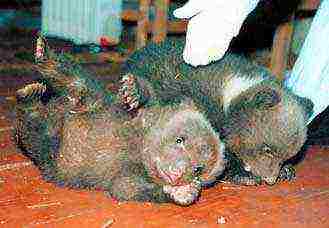
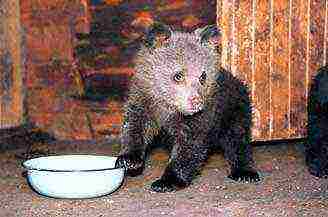
Tasya is waiting for the supplement.
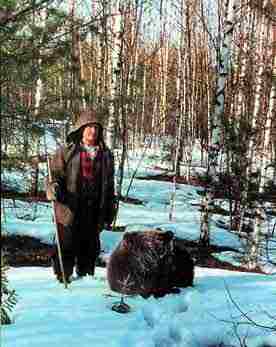
Spring has come. It's time to take pets to the forest.
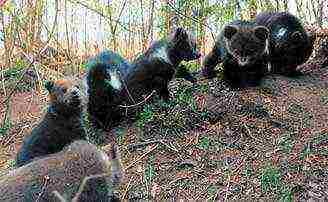
Although there are no strangers at the biological station, the cubs are sensitive to suspicious rustles. To survive, they must be constantly alert.
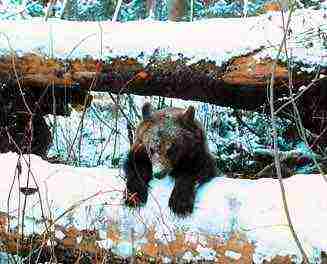
The closer the winter, the more concentrated the cubs look into secluded places: they are looking for where to wait out the cold.
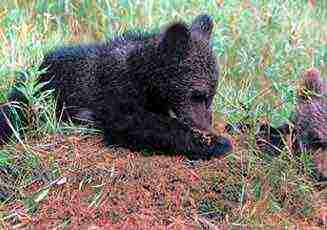
By destroying anthills, the cubs eat ants and gain the supply of fat necessary for winter.
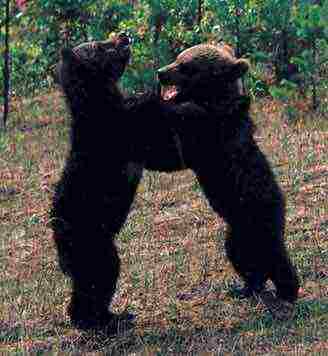
Grown up cubs love to measure their strength.

Valentin Sergeevich and Svetlana Ivanovna rarely can afford to relax with friends.
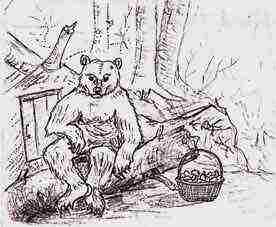
Illustration by V. S. Pazhetnov for the tale of bears, written by himself.
‹
›
It was the first decade of January, the Epiphany frosts were. One of these days, the fragile, frosty silence was broken by the roar of a powerful engine. A man jumped out of the high cockpit.

When he opened his jacket, we gasped - there were three living lumps with red noses, the same paws and still bleeding umbilical cords. During the founding of the station, we had to raise babies of all ages, but such crumbs were given to us for the first time!
And this sad story happened like this. Lumberjacks were working on a distant forest plot. A skidder was dragging the trees to the loading bay with a loud roar. Here the trunks were loaded onto a timber truck. The howl of motors and the rumble echoed far and wide. Despite all the approaching noise, the bear, who had made a den in this place, overcame fear, patiently endured the terrible noise of logging for her subtle hearing, as she felt that offspring were about to appear.
But when a tree fell right into her den, she could not stand it. A feller, who was cutting off a huge pine tree, which with a whistle fell into the young growth of dense Christmas trees, saw a bear running away.
In the early morning of the next day, hunters who had permission to shoot came to the plot.
Usually a beast raised from hibernation goes far, climbs into the thicket and lies down so as to look at its trail. But this bear had only moved one kilometer away and lay in the hazel thickets, right in sight. Here he was overtaken by a shot. When the bear was turned over, we saw three small cubs. Then the hunters realized that they had killed a bear that had just given birth to cubs. They heard that we were raising babies and went straight to the station. The hunter, who brought the cubs, threw up his hands, swore that he would never go hunting for a bear in the winter when the animals were in their den again in his life.
The cubs barked shortly, like kittens, in thin voices. We felt their paws, stomach and mouth - they were warm. A good sign. The hunters guessed to immediately wrap the newborns in a fur jacket. Babies can do without food for a day or two. But thermoregulation at this age has not yet "turned on" for them, even at room temperature they can catch a cold. It is difficult to treat pneumonia, sometimes even injections of penicillin do not help.
In warm diapers, on the stove, the cubs quickly calmed down and fell asleep. Now it was necessary to closely monitor them: the temperature in the “nest” should not be allowed to fall below 30 degrees, but overheating (above 38 degrees) is no less dangerous for them.
As soon as the cubs were twirling around in the basket, we weighed them and gave each one a little fresh cow's milk to suck from a papilla put on a penicillin bottle. Older cubs, who know the taste of mother's milk, twirl their faces at first, frown - they do not like the new smell. But these babies greedily clung to the nipples at once - they managed to get hungry.
The bear's milk is thick, fatty, it has everything you need. Cow's milk (we also add infant formula to it) has a completely different composition, but gradually the cubs get used to it. Newborns have tiny ventricles and need to be fed every two hours. Babies are born small - 15-18 centimeters and grow very slowly. Thus, the mother still has a reserve of fat, which is necessary in order to survive the spring lack of food.
***
My wife Svetlana Ivanova and I were on a restless watch. In addition to the newcomers, we already had fifteen cubs. While you feed some, the turn of the others has already come. The bear licks the cubs with her tongue - she immediately washes and massages the lower abdomen, otherwise they may have constipation. We have to separate this procedure into bathing and massage. And you also need to keep an eye on the diapers, wash them, change them as needed, dry them, and make the “beds” again. Dirt causes fungus, which is then very difficult to fight. Dust is also dangerous for cubs: it clogs up in the nasal septum, interferes with breathing normally, which causes seemingly unreasonable attacks of aggression.
Bottles and bowls must also be kept perfectly clean. Everything has to be doused with boiling water. Chemical cleaning agents are excluded for the same reason that I cannot use lotions and my wife cannot use perfumes and creams: so that babies do not remember a certain smell. We went to them in the same clothes, which we left in the fresh air so that the “human” smell would disappear. We always have gloves on our hands. And when the cubs grow up, I will put on a hood, and I will lower the net over my face.
We were very worried about whether our crumbs would be able to leave, but everything turned out well: they developed as expected. The ears opened on the fifteenth day, and a month later - and small, like black beads, eyes. So far, they moved slowly, awkwardly waddling: the front legs with long claws at this age are stronger than the hind ones. They were named Tasya, Taras and Timofey (according to the first letter, as is our custom, of the region where they were found).
A few weeks later, at the sight of an unfamiliar object, they got up on their hind legs, snorted to frighten the “enemy”, made threatening attacks, but immediately backed away fearfully.
Now they drank milk to their heart's content until they gave up the nipple themselves. And we fed them in three hours only in the afternoon. From 12 at night until the morning we could already afford to sleep.
By the time the cubs were two months old, they had noticeably grown stronger, began to walk and play. By the age of three months, we fed them after four hours and carried them out of the house into the barn. At night they sat in a special box, insulated from the sides. During the day, they opened the doors in the shed, let the cubs out of the box, and in good weather they frolicked for hours in the sun.
HOW THE KINDERGARTEN APPEARED
Many years ago, in the Central Forest State Nature Reserve, they began to study the life of brown bears, but how the cubs grow and develop in the wild was least known. You can't look into the bear's den, and even after leaving the den, you can't approach them. The mother bear jealously guards the cubs and will not tolerate the presence of a person next to her. Professor of the Moscow State University. MV Lomonosov Leonid Viktorovich Krushinsky suggested that the reserve workers raise orphaned bears in order to describe their behavior. Thus began a long-term experiment, which we were able to carry out thanks to the support of the International Fund for the Protection of Animals.
For several years, employees of the reserve and scientists from the Institute for Nature Conservation traveled across the Tver region until they found the right place in the Toropetsky district. To the village of Bubonitsy, where there were abandoned huts, there were still wires on old wooden poles, the same old transformer stood and worked properly, which was very important: modern life and scientific work are simply impossible without electricity. The village and its surroundings turned out to be an ideal place: here it was possible to organize a biological station of the Central Forest Reserve.
The village was located next to Lake Chistoe. Hence the name of the station - "Clean Forest". My wife and I moved to a new place, my son moved with his family later. We settled at first in one of the houses, which looked stronger and better than the others. Life at the biostation did not start easily. I had to simultaneously arrange life and conduct scientific observations.
***
We learned a lot along the way. The experiment immediately went in the right direction, because we had been studying the habits of the forest owner for many years. After all, our family has been studying the customs and habits of the forest giant for 30 years: the good-natured and trusting Toptygin from children's fairy tales, a cheerful circus performer, a sad prisoner in an iron cage, a destroyer of peasant farms, a coveted and honorable trophy of a hunter. But you can truly understand and appreciate this beast - the pride of the forest - only in nature.
For the first time, a bear brings newborns “into the light” in late March - early April (only in Siberia and Kamchatka - in May). The family does not immediately leave the winter apartment. First, the mother makes a kind of trial exits. Rolling, tossing and turning, ridiculously kneading the sides after a long sleep and cleaning the skin of debris, leaving dirty spots on the snow. Then he arranges a bed of needles, spruce paws, brushwood and lies in the sun, as if filling up. From time to time, babies crawl out after her.
During wintering in bears, the intestines contract, the walls become thick, and the lumen is narrower. A dense clot forms in the flask of the rectum, the so-called "plug". To get rid of it, bears feed on last year's grass, rot, rowan bark, spruce needles - this activates the intestinal tract.
We, following the example of a caring mother, when releasing pets, make sure that they are not overcooled. First, we let them frolic for a very short time. Gradually, the time spent in nature is increasing. As soon as the animals find themselves in their native element, all their ailments and ailments are removed as if by hand.
From mid-May to June, the grass grows vigorously - and the bears quickly gain weight. The she-bear at this time continues to feed the babies with milk, so they do not suffer from starvation. And we also continue to feed them, otherwise they may die of hunger: after all, they do not yet have the skill of living independently, and there is not enough food in the forest. But here it is very important to refrain from pity. If we feed them "from the belly", they will not look for food themselves and it will be difficult for them to adapt.
We place the bowls at a distance of 70 centimeters from one another, so that all the kids receive food at the same time and no one is left out. The area where the young grow up is fenced with wire mesh to protect the young from the invasion of larger animals and stray dogs.
During this period, looking for the right herbs and roots, the cubs at the same time learn to navigate in the forest, to avoid open spaces. If they come across thawed patches on their way, which in early spring are soaked through with water, they loudly slap their paws through the puddles, so that the spray scatters in all directions. My task is to keep an eye on them, but in no case let them get used to me.
To survive in the wild, the bear must learn to recognize smells and sounds: dangerous and not dangerous; find the right road; avoid encounters with large animals.
An experiment carried out with orphaned bears showed that babies are able to adapt themselves to living in the wild without being taught by the mother. For this it is necessary that they are in a group of two or more cubs (in this case, imprinting - memorization - happens, so to speak, on top of each other) and have the opportunity to wander through the forest.
By the behavior of the first growing up cubs, we tried to understand how they would relate to the smell of "strangers". If they become afraid and run away, then such bears can be safely released into the wild. They will not go to human habitation and will be able to settle in the wild.
WHERE DO THE SKILLS COME FROM?
When bears start weddings in May-June, a bear with her second year of life cubs - lonchaks - comes to the place where she can meet a male. Smelling the scent of a male bear, the cubs run away. And no wonder. Bears are big individualists, they do not tolerate anyone on their territory. And they can even attack the cubs. Therefore, lunches climb the trees, hide.
The she-bear stays with the male for several days. Unwillingly, the cubs have to start an independent life. Actually, thanks to this genetic program embedded in them, we manage to return them to the forest.
***
From the end of summer, closer to winter, the main concern of the bear is to prepare for hibernation - to gain more fat. The cubs who returned to her do the same.
First, bears accumulate subcutaneous fat, then internal fat. The so-called brown fat is located near the kidneys, heart, in the interscapular and lumbosacral zones, in the intermuscular layers of connective tissues, accumulates all the time. There is very little of it, but it is he who supports the metabolism during the hibernation period (and prepares the males for the race). Brown fat - the custodian of vitamin E (tocopherol) - absorbs the components of many plants. Subcutaneous fat (storage of not only nutrients, but also water) acts as a thermal insulator.
Scientists of the past divided bears into “vultures” and “anthills”, that is, predators and “vegetarians” (they have enough proteins to develop the necessary reserves, they get them, ruining anthills).
The number of plants that bears eat for food is more than 75 species. Often eaten - 25. The main diet includes 12-15 plant species. So bears can survive even in the poorest forest.
The owners of the forest love blueberries, hazel nuts, rowan, oak, and apples. Oats are their favorite delicacy. Nothing helps them gain fat like oats.
A bear can eat over 20 kilograms of vegetation per day. It is not difficult for them to find food in our places. This puts the brown bear in a particularly advantageous position in the predator squad.
In the Tien Shan, bears feed on tulip bulbs, in Altai - on the roots of a penny, cones, in Kamchatka they catch anadromous fish - salmon.
***
The biggest experiences of the first autumn (1990) were associated with one thing: will our pupils lie down in a den? Will they cope with this difficult task for them themselves, without having any skill?
Not without excitement, we watched how in the morning the withered grass was already beginning to silver with frost, and by the evening a cold gray fog swirled over the glades. Prolonged drizzling rains began. The forest is saturated with dampness. Old experienced bears have already looked after winter apartments for themselves.
Our cubs lay in one place for a long time, chewing something sluggishly. Sometimes they started games, but they quickly died down. But then a prickly north wind blew, the first white flies flashed. The cubs got worried, began to move from one tree upturned by the roots to another, sniff, peer ... Finally, they stopped near a place with a fairly deep notch, walked along a smooth trunk with peeled bark, looked inside several times, poked something, sniffed the knotty roots, then began to busily drag, crawling backwards (just like adult bears, and no one showed them how to do it), spruce paws, branches, dry grass.
The bedding layer for a den is usually 10-12 centimeters, sometimes forest debris and grass go to it.
According to the structure, earthen dens are divided into: a person, or an entrance, - 40 by 40, then there is a neck (it is most often absent) and a nesting chamber itself - 60 by 80 - 90 by 110 at a height of 69-110 centimeters. Bears usually build earthen dens in the North, where winters are long; semi-soil (without a camera) and riding dens - in central Russia, when natural niches are used, most often under semi-rotten stumps.
Since ten years have passed since the first "graduation", we had no doubt that Tasi, Taras and Timofey would also succeed. Together with the rest of the cubs, they, not spoiled, not pampered, have completely mastered the forest, gained weight. Each pet has a tag on its ear with the biostation address. Our charges began to look at the gloomy sky, they guess (what smart guys!) That they need to look for a bed.
When the cubs moved further away, I carefully examined how their winter home looks like. One bear even made something like a small pillow for himself, others turned out to be lazier - they did not take care of the pillow. But even among adults, everyone prepares to meet winter in different ways. Some carefully plug all the cracks with bunches of grass, warm themselves thoroughly. And others will throw a couple of branches - and everyone thinks that this is enough for them.
My tent was located not far from the place where the cubs were preparing to meet the winter. I was very much afraid that someone might disturb them. Not only because the experiment will fail. After all, I'm used to babies, I'm used to taking care of them. And I wanted the wintering to go well.
And so, when the snow fell, the cubs hid in their shelter. After a while there was a puffing sound from there, then I heard snoring. The cubs fell asleep. But when the snow covered everything with an even cover, silence fell in the den. And only then I finally breathed a sigh of relief and was able to return home.
They lay down on November 28. My watch is over. And it was not easy. After all, I had no right to take food with me, so that its smell would not reach the cubs, I could not even warm up tea for myself. And sit all day in a tent in late autumn!
Our kindergarten starts working in January. And it closes with the first snow. There comes a short break when you can finish the publication of scientific papers, share your experience with colleagues, put things in order at the biological stations, take into account the mistakes of the past and prepare for meeting new pets.
And in the spring, at the end of March, our pets will disperse and forget that they grew up together. How ordinary bears forget about it. Their home will be the forest, where they were born and where they will return safely.
A person can not only harm nature.Our many years of work have shown that a person is able to return to nature her pets in trouble.
The brown bear is found in taiga forests, mountains and conifers, which are abundant in windbreaks. Large populations can settle in permanent habitats. In the midst of winter, the female gives birth to brown cubs. How do they develop and grow up? What happens after a little brown bear is born?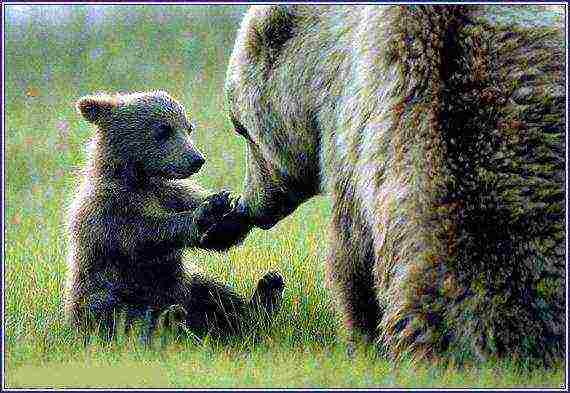
It should be noted that the mother bear does not have a permanent pair. During the mating season, which begins at the end of spring, several males apply for the role of a spouse at once. During this period, they are extremely aggressive, fiercely compete with each other, fights often end in the death of one of the rivals. The winner forms a pair with a female, but the union lasts no more than a month. Then the bear remains alone, and in winter, usually in January, brown bears are born. Most often there are two of them, and they are very tiny. The weight of one bear cub rarely exceeds 500 grams.
 In the first two months, brown bears do not leave their dens, remaining all the time at the side of their mother. It is during this period that the family is most vulnerable. Since brown bears do not belong to protected rare species, with the exception of some, the hunting season is open for them. Bear dens are often a desirable object for hunters. In places where a significant population of bears lives, bear trails are very noticeable, along which these animals are found.
In the first two months, brown bears do not leave their dens, remaining all the time at the side of their mother. It is during this period that the family is most vulnerable. Since brown bears do not belong to protected rare species, with the exception of some, the hunting season is open for them. Bear dens are often a desirable object for hunters. In places where a significant population of bears lives, bear trails are very noticeable, along which these animals are found.
A newborn brown bear cub is born with a thin coat, with covered ears and eyes. After 2 weeks, the ear holes are completely formed and the eyes open. The first exit from the den occurs at 3 months. By this time, brown bears have reached the size of an average dog and weigh from 3 to 6 kg. All this time they feed exclusively on milk, but with the beginning of summer a new food appears - plant food. Imitating the mother, the cubs begin to try new delicacies for themselves - roots, berries, nuts, wild oats, worms and other insects. During the first year of life, the animals do not leave their mother. They continue to live with her, spending another winter together.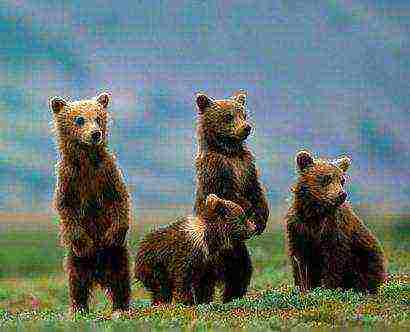
Having reached the age of 3-4 years, individuals are considered sexually mature and begin to lead an independent life. But they reach full maturity at the age of 8-10. The matured brown bear is a large forest animal, weighing up to 300-400 kg. However, one species is known, called "kodiaki" and living in Alaska, in which males weighing up to 750 kg are found.
The color is most often brown, but can vary from straw yellow to dark, almost black. The fur is very dense, dense, long. Moreover, the inhabitants of the northern latitudes have longer hair than the southern inhabitants. The tail is short, hidden under the fur. Long black claws reach 10 cm in length.
Having become an independent adult animal, the brown bear begins to look for a separate territory for itself, and in males their personal area is 7-10 times larger than that of females. Despite their formidable appearance, these animals feed on plant foods and invertebrates, feeding on subcutaneous fat during the summer. But if the bear has not gained enough weight, then it may wake up in the middle of winter and go hunting. They are extremely aggressive, attacking everyone who comes in their way, and pose a serious threat to humans.
Can a person pick up a bear cub, raise him and release him into the wild prepared for any difficulties? The answer is yes. More than one and a half hundred clubfoot owes talented Russian scientists a full life in the wild.
In the village of Bubonitsy, over the past 20 years, more than one and a half hundred bears have been raised and returned to nature.
In 2010, a bear cub was found near the town of Ostashkov. It weighed just over 300 grams, although newborn bears usually weigh half a kilo. The baby was taken to a biological station in the village of Bubonitsy, where several orphaned bears already lived this year.The newcomer, according to tradition, was named after his place of birth - Ostakh - and they began to fight for his life.
Like other cubs, the Pazhetnovs fed Ostakh with milk, then transferred to porridge. But then it turned out that the baby's hind legs did not move well. The Pazhetnovs did not give up. Ostakha began to separately add ground and oven-burned bones and eggshells to the porridge - calcium therapy was used.
Until April, all the cubs were kept in a special house, and then they were taken to a spacious open-air cage in the forest. Now people tried to reduce contact with cubs to a minimum - once a day they brought them porridge, silently left it and left. And they gradually reduced the amount of food given out - as the animals learned to eat pasture. In two or three months, when the instinct of self-preservation awakens in the little ones, it will be possible to open the doors of the enclosure - and the teenage bears will begin to leave for a short time into the forest. And one day they will leave completely to start a free life.
In the village of Bubonitsy, over the past 20 years, more than one and a half hundred bears have been raised and returned to nature.
But not Ostakh - he still lived in the house and crawled, dragging his hind legs like flippers. Veterinarians came, shook their heads - Ostakh will never be able to walk normally. Svetlana Pazhetnova pitied him to tears: a free animal is doomed to eternal life in a cage.
However, until recently, the cage was the only way to survive for hundreds of cubs, who were orphaned every year throughout Russia. The she-bear gives birth to offspring in January. Her babies toss and turn, making themselves comfortable, closer to the nipples with milk. The bear is worried about it, she also tosses and growls. This whole noisy family is easier for hunting dogs to smell than a lonely bear.
And when the dogs have sensed a den, the bear is either killed by the hunters, or, frightened by them, the female runs away, abandoning the cubs (the maternal instinct, forcing her to desperately protect the offspring, will wake up in her only in the spring, after the family leaves the den). There were always few options for the further development of events for her cubs, helpless, often still blind lumps (there are from two to five): death, a cage in the master's yard and a zoo for special "lucky" ones.
And feed the cubs and return them to the forest? The problem of the return of large predators to nature is still almost not studied. In the wild, the same bears, before starting an independent life, spend a year and a half with their mother, for how long it was believed, she teaches them to look for food, defend themselves, build a den ... in captivity, bears and similar animals are impossible in principle. And here I am walking through the village of Bubonitsy, where over the past 20 years, more than one and a half hundred bears have been raised and returned to nature.
The buboes lie in the distance from railways and highways. This is the Tver region, to the nearest town, Toropets, - 60 kilometers. Along the road running uphill, which today, at the end of February, is snow-covered and illuminated by an incredibly bright sun, a dozen wooden houses are scattered like farmers - at a distance from each other. Only four or five of them are inhabited all year round. The road is crossed by chains of footprints, to which Valentin Sergeevich Pazhetnov draws my attention.
- And here the fox ran, over there the trace from the tail. You know, it is thanks to the tail that the animal can turn sharply, pushing itself off the air, or even out the trajectory when jumping.
Valentin Pazhetnov, Doctor of Biological Sciences, seems to know everything about the tracks. In his youth, he was a hunter-fisherman who was thrown into the taiga for months. Then he changed many professions and positions, was both the director of the Central Forest Reserve, and a senior researcher of the same reserve (in this sequence).And it was Pazhetnov, who appreciated his acquaintance with the forest, in the mid-1970s, Moscow State University professor Leonid Viktorovich Krushinsky, a leading Russian specialist in the study of animal behavior, proposed an unusual experiment - to create a so-called surrogate family with bears.
In the fall, the cubs took a fancy to one fallen tree, swarmed around it for several days, and when Pazhetnov once again brought them to this place, they began to dig a den. Sami, and no one taught them! It was a sensation.
Pazhetnov became a guide for the cubswho, leaving the den at the age of three months, mistook him for their mother and, obeying ancient instincts, followed their "mother." And the person did not come into contact with them, did not play, did not stroke, did not talk. He just walked. And I watched - what the cubs can do when there is no bear teaching them.
- At first, however, I left them feeding, - recalls Pazhetnov. - I made balls from powdered milk, yolk, butter, sugar, which gave a lot of energy. And the small amount of food made the cubs feel hungry and try to get food on their own.
Brown bears are omnivores, but mostly herbivores. In the spring, they feast on the first grass. Then - blueberries, aspen leaves, rowan. They love apples, in August they gladly come to the oats known to all hunters - oat fields. True, as the work of the Pazhetnovs showed, there is more calorie content in aspen leaves than in oat grains.
“Since July, they have already eaten on their own,” continues Valentin Pazhetnov. - And I took the backpack collected by my wife, Svetochka, and went on a trip with the bears. After 12 days we met at the agreed place, Svetochka gave me a new backpack with food and a letter, and I returned her empty one with my letter.
Svetlana Pazhetnova knows how to read footprints and navigate the forest no worse than her husband - and has always been his most faithful partner. In her youth, she went hunting in the taiga for months - with her husband. When Valentin Sergeevich was the director of the reserve, she was engaged in paperwork. When Pazhetnov began to study the brown bear, Svetlana Ivanovna's specialization was the bear diet. Valentin Sergeevich still calls his wife "Svetochka" most often. And then, in the 1970s, when the spouses exchanged backpacks, they could not throw a few words at the same time: the animals were not supposed to hear human speech.
But the sacrifices paid off handsomely. It turned out that the cubs themselves, without prompting, can find food. And in the fall they took a fancy to one fallen tree, swarmed around for several days, and when Pazhetnov once again brought them to this place, they began to dig a den. Sami, and no one taught them! It was a sensation.
Krushinsky, who became Pazhetnov's scientific advisor (which Valentin Sergeevich considers a great success, recalling the mentor with great gratitude), dreamed of developing a methodology for returning bears to nature. But the technique appeared much later.
In 1985, Valentin and Svetlana (two of their children had already grown up and became scientists themselves) moved to the abandoned village of Bubonitsy, in which there were only two residents who lived at different ends of the village. The Pazhetnovs planned to study the behavior of brown bears in the vicinity. For days they walked through the forest, following the tracks, learning what the local bears were doing, what they were eating, with whom they interacted. Habitual work. But in the early 1990s, the zoos, having switched to self-sufficiency, refused to accept the cubs found in their dens, and conscious hunters began to bring the bears to the Pazhetnovs, having heard that the largest Russian bear specialists live in the abandoned Bubonitsy. They already know what to do!
The Pazhetnovs did not refuse, although no one gave them money to feed the cubs. Techniques were invented along the way. In 1990, four of the first seven cubs were released into nature.Three of them were lifted by an adult male at the end of May, during the beginning of bear weddings - he smelled a smell from afar, ran to the aviary and pounded on the cage until it opened ...
In the early 1990s, researchers across the country were busy with survival, while the Pazhetnovs were busy rescuing cubs.
- We had a cow, - Svetlana Ivanovna cheerfully recalls, short, still youthful, agile and optimistic. - So, there was milk for the cubs, but cereals, however, had to be bought.
And in 1995, Maria Vorontsova, director of the Russian branch of IFAW, the International Fund for the Protection of Animals, which has been helping animals in trouble since the 1960s, learned about the work of the Pazhetnovs. The foundation appeared in Russia in 1994, and since 1995, it has fully financed the work within the IFAW project “Center for the rehabilitation of orphaned bears”. Now the Pazhetnovs bring bear cubs from all over Central Russia, a couple of times they brought them from Siberia. They are also released in different places - someone is taken closer to home, someone - to the reserve "Bryansk Les", where with the help of the Pazhetnovsky bears, the disappearing population was restored.
We finally reach the Pazhetnovs' house - in the second half of it, the bear cubs brought this year are sleeping in warm boxes in the dark. They take them out of there, only to feed them - at first they feed them every two hours, then less often. While the cubs are afraid to leave them in a separate house, suddenly the electricity will turn off.
The cubs at the age of one and a half months look like ... Yes, they are not like anyone. Well, or they look like aliens. On little plush aliens. Each of the four equally dexterous paws is crowned with five clawed fingers. Black wool. White-collar. And the blunt muzzles of plush toys. Zosia and Zakhar, cubs born in 2012, lay flat on a mat in the full length of their proud 30 centimeters (taking into account their outstretched legs), waiting for milk. Both squeak and shout - clearly shout "mom". But they do not hear each other - in the first month of life, the bears' ears are covered with a membrane.
Zosia is trying to crawl on her bellies, although her limbs are still poorly obedient. She is caught, returned - but the bear sets off again. His limbs obey Zakhara even worse, therefore, trying to crawl, he only spins around his axis like a top. The brother and sister are growing too fast, it is already difficult for their paws to carry their dense bodies - and Sergey Pazhetnov, the son of Valentin and Svetlana, after consulting with his father, decides to cut back on the bear diet.
The Pazhetnov family has four certified hunting biologists - Valentin, Svetlana, their son Sergei and grandson Vasily. Everyone is working on the project. And none of them hunt.
- For more than 15 years, both husband and son have not taken a gun in their hands, - Svetlana Ivanovna recalls.
Valentin Sergeevich himself is not against bear hunting. But for many years he sought to ban "hunting in a den," that is, in January-February. Even now, when Pazhetnov talks about this, his voice trembles with indignation:
- You have a license for one bear, one and hunt. You can't deprive nature of a few more cubs at the same time!
Largely thanks to the efforts of Pazhetnov, a few years ago, bear hunting in January-February was banned in the Tver region. Since 2012, it has been banned throughout Russia. But, alas, this did not solve the problem of orphaned bears - and it’s not just poaching. So, the mother of Zosia and Zakhara was accidentally scared by a dog. Hunters brought four more cubs in February quite openly. Sergey takes these babies out of the box, preparing them for feeding. Even the largest of them seems to be the size of two-thirds of Zosia and Zakhar. Moreover, he is completely blind - his eyes have not yet opened. And the two smallest are a little more than a palm each, they have only one eye open so far, and the larger one looks like a fragile monkey - it is not black, but some kind of whitish-gray-pinkish.
The cubs start messing around, playing "king of the hill" - each trying to climb onto the other.Everyone fails to do this at the same time, someone constantly rolls down, someone crawls out from under someone ... Probably, this is instinct at work - in the den, the kids need to sit on their mother so as not to freeze. The only girl in the six, Zosia, the largest and most daring, easily prevails over and over again.
- It will be the dominant, - Valentin Sergeevich considers. Dominants - these can be not only males, but also females - are defined as follows: in July-August, when half-year-old cubs begin to leave the enclosure, looking for food, they are usually divided into groups of two or four. Although adult bears are territorial loners, pre-puberty bears (the first two years of life) are highly social. The group is "led" by the most courageous and decisive, the dominant, the rest follow him. At first, the group regularly returns to the aviary - but one autumn day it may not come. He will stay in the forest and start building one den for all.
Not all bands release in the first year - some of the cubs are not yet ready to winter on their own. Then they are left in a den on the territory of the aviary until spring. Now in it, a few kilometers from us, the group of Demyan, a leader with a difficult fate, is dozing.
Almost a year ago, at the beginning of May, rural schoolchildren of the Demyanovsky district of the Novgorod region, walking along the path, saw a lonely four-month-old bear cub on the side of the road. He was not afraid of children - up to five months, the cubs are not afraid of anything at all, their instinct of self-preservation is still dormant.
The teddy bear lagged behind the family. This happens - the bear does not know how to count, and if someone from her brood is too weak and lagging behind, she does not notice it. She will not notice anything suspicious at all until she is alone.
The children took the bear to the huntsman, who took him to the Pazhetnovs. The pupils from Bubonice, who had already settled in the aviary, greeted the weak stranger with caution and at first ignored it. But the bear grew up, fed - and by the end of the summer he suddenly became the leader of the group.
Bears reared by humans should not make contact with humans in the future. To make sure that their "graduates" do not perceive people as a source of handouts, the Pazhetnovs put ear tags on the clubfoot. Unfortunately, information about the marked animals appears either during random observations, or when such bears are hunted by hunters (fortunately, not often). One mark returned on a seven-year-old, healthy, well-fed male. But it is known that not a single bear with an ear tag went out to people. And it happened that the marks saved the life of the animals - for example, once the local huntsman Volodya, who organized a hunt for visiting amateurs, seeing that the dogs raised the marked bear, managed to shout: “Don't shoot! This is Pazhetnovsky! "
It is more effective to track bears through radio collars, and even better - through GPS collars, which have already been tagged with several bear cubs. But the devices run out of batteries in a year or two, and it is dangerous to change it. Once there was an attempt - with teenagers Kira and Klara, which did not lead to anything good - except perhaps for an amazing observation.
In April 2005, these one and a half-year-old bears were released from the enclosure, providing Kira with a GPS collar. The collar did not seem to bother Kira, but the battery was low, and in the winter, when Kira was found in the den, she was immobilized, and the collar was changed. Kira spent the winter alone, where Klara was, no one knew. In the spring, at a signal, the collar was found on the floor of another, empty den. And there were clearly visible teeth marks on it. Apparently, the new collar bothered Kira, she went to her friend, knowing where she spent the winter, and Clara, realizing that she needed help, pulled the collar off Kira.
The fate of the non-traveling Ostakh from Ostashkovo is directly connected with the radio collars. Svetlana Pazhetnova continues to tell his story, and her voice trembles.
- In April, I took him out into the sun so that the joints would warm up.And since I brought him the porridge there, - Svetlana Ivanovna is more and more worried, - put the bowl down, left, and suddenly for some reason turned around, I looked - and he was leaning on his hind legs to get the porridge from the bottom. I was stunned to see him leaning on weak, gnarled legs. So they will work!
And so it happened. Later, when Ostakh lived in an aviary, he was provided with a radio collar, thanks to which it is known that Ostakh dug a den together with a bear cub Genka. Genka Pazhetnovs were also called Accomplice, because in his early youth he was involved in a crime - Genka was illegally traded in the market, from where he was removed with the help of a deputy who sympathized with the bear cub. At the end of March, the cubs left the den - and suddenly the signal disappeared. Svetlana Pazhetnova was in despair. And at the beginning of May, guys from a neighboring village came running to her, shouting:
-Svetlana Ivanovna, Ostakh is alive! The road crossed to Kosilovo, not far from the bus stop!
Text: Maria Kozhevnikova
